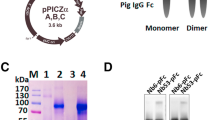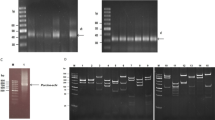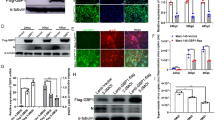Abstract
Objective
To isolate specific nanobodies to porcine reproductive and respiratory syndrome virus (PRRSV) non-structural protein 4 (Nsp4) and investigate their potential antiviral activities.
Results
Three PRRSV Nsp4-specific nanobodies were isolated from a phage display library of the variable domains of camelid heavy chain-only antibodies. Nanobody genes were introduced into MARC-145 cells using lentivirus vectors to establish cell lines stably expressing nanobodies. These intracellularly expressed nanobodies were tested for interaction with PRRSV-encoded Nsp4 within PRRSV-infected MARC-145 cells. Nb41 and Nb43 intrabodies each potently inhibited PRRSV replication, protected MARC-145 cells from PRRSV-induced cytopathic effect and fully blocked PRRSV replication at an MOI of 0.001 or lower.
Conclusion
Intracellularly expressed Nb41 and Nb43 potently suppressed PRRSV replication in MARC-145 cells. Nanobodies hold great potential for development as novel antiviral treatments for PRRSV infection.




Similar content being viewed by others
References
Boons E, Li G, Vanstreels E, Vercruysse T, Pannecouque C, Vandamme AM, Daelemans D (2014) A stably expressed llama single-domain intrabody targeting Rev displays broad-spectrum anti-HIV activity. Antiviral Res 112:91–102
Conrath KE, Wernery U, Muyldermans S, Nguyen VK (2003) Emergence and evolution of functional heavy-chain antibodies in Camelidae. Dev Comp Immunol 27:87–103
da Silva A, Santa-Marta M, Freitas-Vieira A et al (2004) Camelized rabbit-derived VH single-domain intrabodies against Vif strongly neutralize HIV-1 infectivity. J Mol Biol 340:525–542
Deschacht N, De Groeve K, Vincke C, Raes G, De Baetselier P, Muyldermans S (2010) A novel promiscuous class of camelid single-domain antibody contributes to the antigen-binding repertoire. J Immunol 184:5696–5704
Du EQ, Tikoo SK (2010) Efficient replication and generation of recombinant bovine adenovirus-3 in nonbovine cotton rat lung cells expressing I-SceI endonuclease. J Gene Med 12:840–847
Escors D, Breckpot K (2010) Lentiviral vectors in gene therapy: their Current Status and Future Potential. Archivum Immunologiae Et Therapiae Experimentalis 58:107–119
Holtkamp DJ, Kliebenstein JB, Neumann EJ et al (2013) Assessment of the economic impact of porcine reproductive and respiratory syndrome virus on United States pork producers. J Swine Health Prod 21:72–84
Huang C, Zhang Q, Guo XK, Yu ZB, Xu AT, Tang J, Feng WH (2014) Porcine reproductive and respiratory syndrome virus non-structural protein 4 antagonizes beta interferon expression by targeting the NF-kappaB essential modulator. J Virol 88:10934–10945
Kabat E, Wu TT, Perry HM, Gottesman KS, Foeller C (1991) Sequence of proteins of immunological interest, vol 5, 11th edn. US Public Health Services, Washington, DC
Li Y, Tas A, Sun Z, Snijder EJ, Fang Y (2015) Proteolytic processing of the porcine reproductive and respiratory syndrome virus replicase. Virus Res 202:48–59
Liu H, Wang Y, Duan H et al (2015) An intracellularly expressed Nsp9-specific nanobody in MARC-145 cells inhibits porcine reproductive and respiratory syndrome virus replication. Vet Microbiol 181:252–260
Lo AS, Zhu Q, Marasco WA (2008) Intracellular antibodies (intrabodies) and their therapeutic potential. Handb Exp Pharmacol 181:343–373
Maenza J, Flexner C (1998) Combination antiretroviral therapy for HIV infection. Am Fam Physician 57:2789–2798
Murtaugh MP, Genzow M (2011) Immunological solutions for treatment and prevention of porcine reproductive and respiratory syndrome (PRRS). Vaccine 29:8192–8204
Rothbauer U, Zolghadr K, Tillib S et al (2006) Targeting and tracing antigens in live cells with fluorescent nanobodies. Nat Methods 3:887–889
Tian X, Lu G, Gao F et al (2009) Structure and cleavage specificity of the chymotrypsin-like serine protease (3CLSP/nsp4) of porcine reproductive and respiratory syndrome virus (PRRSV). J Mol Biol 392:977–993
Vincke C, Gutierrez C, Wernery U, Devoogdt N, Hassanzadeh-Ghassabeh G, Muyldermans S (2012) Generation of single domain antibody fragments derived from camelids and generation of manifold constructs. Methods Mol Biol 907:145–176
Wang C, Huang B, Kong N et al (2013) A novel porcine reproductive and respiratory syndrome virus vector system that stably expresses enhanced green fluorescent protein as a separate transcription unit. Vet Res 44:104
Xu AT, Zhou YJ, Li GX, Yu H, Yan LP, Tong GZ (2010) Characterization of the biochemical properties and identification of amino acids forming the catalytic center of 3C-like proteinase of porcine reproductive and respiratory syndrome virus. Biotechnol Lett 32:1905–1910
Acknowledgments
This study was funded by the National Natural Science Foundation of China (31430084).
Supporting information
Supplementary Table 1—Primers used in this study.
Supplementary Table 2—Enrichment of Nsp4-specific phages during subsequent rounds of panning.
Supplementary Figure 1—Expression and purification of the Nsp4-NHis recombinant protein.
Supplementary Figure 2—Camel immune response raised against Nsp4.
Supplementary Figure 3—Amino acid sequence alignment of isolated nanobodies with human VH (hVH).
Author information
Authors and Affiliations
Corresponding author
Additional information
Hongliang Liu and Chao Liang contributed equally to this study.
Electronic supplementary material
Below is the link to the electronic supplementary material.
Rights and permissions
About this article
Cite this article
Liu, H., Liang, C., Duan, H. et al. Intracellularly expressed nanobodies against non-structural protein 4 of porcine reproductive and respiratory syndrome virus inhibit virus replication. Biotechnol Lett 38, 1081–1088 (2016). https://doi.org/10.1007/s10529-016-2086-3
Received:
Accepted:
Published:
Issue Date:
DOI: https://doi.org/10.1007/s10529-016-2086-3




